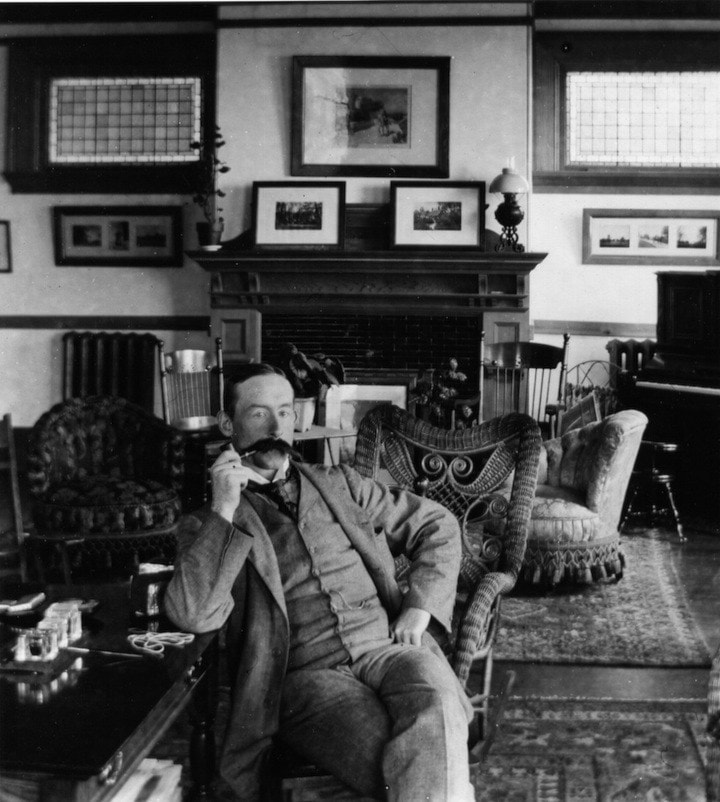Less than a year after he settled in Vancouver, Edward Mahon set out for the West Kootenay. He arrived on the local setting in the summer of 1891 and, as luck would have it, ran into Albert McCleary, who was ready to sell his Lot 181 and return to his Ontario home. He promptly acquired the strategically placed property and then turned his attention eastward.
As autumn approached, he explored the Toad Mountain locality and by October he registered claims in the area, choosing names connected to his homeland for some of them. Castlegary and Weston relate to his ancestral family home in County Galway.
By 1892, action had shifted to Slocan and Rossland mining camps. In June Edward bought the very promising Vancouver claim from Rufus Evans. As adjoining properties were acquired, the cluster was named the Vancouver Group. Work on it and other claims proceeded, came to a halt in the 1894 slump, and resumed as the silver market recovered a couple of years later.
By this time younger brother Gilbert was onside with the mining ventures, maintaining an office in Rossland. John made an occasional appearance as well. Edward’s activities during that decade typically alternated between Kootenay mining from June to October, and the Vancouver area real estate market the rest of the year.
It is not difficult to see how Edward’s vision for the McCleary pre-emption developed. His Kootenay city, with its strategic setting between West Kootenay and Boundary mining camps, and its location at the crossroads of main steamship and railway transportation corridors, could only grow into a seat of government. The opportunity to develop it was presented by a partnership agreement with Augustus F. Heinze late in 1897, as he was building his railway from Trail to Robson West.
Below: Gilbert Mahon (right) managed many Mahon mining interests, including the Prospecting Syndicate of British Columbia, with an office in Rossland. He acquired claims and a townsite lot at Jewel Lake, near Greenwood. Courtesy of Mahon Family Records.

As I discussed in an earlier article, those plans collapsed four months later when Heinze sold out to the CPR and returned to Montana, leaving the Castlegar Townsite in legal limbo well into the Great Depression. Who knows what our city would have looked like had it evolved as Edward had envisioned? We can guess.
The journal Edward kept during his journey to BC makes it clear he had ideas for attractive streets and parks. He criticized the run-away development of New York and praised city design elements of Detroit, Minneapolis, and St. Paul. His vision of proper city planning evolved gradually, with Castlegar being at its early stage. The final stage of his search for an enduring legacy was set in North Vancouver. It culminated in the Green Necklace — Edward’s vision of a loop of greenways, boulevards, and parks that surrounded the city core.
It formed, in his words, “a great artificial lung, encompassing the central town, breathing, pressing, forcing into it health and vitality with that concomitant physical tone, the normal expression of which is sound-bodied cheerfulness. When the great quadrangle with its subsidiary open spaces is perfected, North Vancouver will have attained the greatest evolutionary altitude ever touched by a city, and will stand before the world as the noblest realized conception in city design.”
Edward’s legacy to that city has been preserved and is now entrenched in the city management plan. What about Castlegar, where those ideas were nascent and denied a chance for growth and fruition? Can we not do something to make up for the interference and neglect in the past and recapture some of Edward’s vision?
Castlegar lacks the assets for a magnificent natural park like Mahon Park, or the formally landscaped beauty of the Victoria Park boulevard. Some segment of Millennium Park could yet be developed into a setting closer to Edward’s conception of that riverside gem. There are, however, additional initiatives that could be undertaken to bring Castlegar into closer alignment with Edward’s achievements in North Vancouver.
Main Street (today’s 2nd St.) and Broadway (9th Ave.) have wider rights-of-way than normal streets and could accommodate a central boulevard with trees, shrubs, and ornamental beds. These would vastly expand our Communities in Bloom options and take the sole focus off Columbia Ave.
The revitalization could be done in stages, commencing with the borders of Kinsmen Park, and eventually connect with Millennium Park. Its walkway could be extended upstream along what is left of Edward’s River St. And a new mini-park at the foot of First St. could anchor that segment, and honour Edward’s contributions, as well as offer a fine viewpoint for the Waldie Island herons.
Those developments would further invigorate downtown Castlegar, where it all began.
Walter Volovsek’s website can be found at trailsintime.org
Previous installments in this series
Edward Mahon: A stimulating childhood
Intrigues: Castlegar’s lacklustre childhood
Perceptions: Adrift on the River of Life
